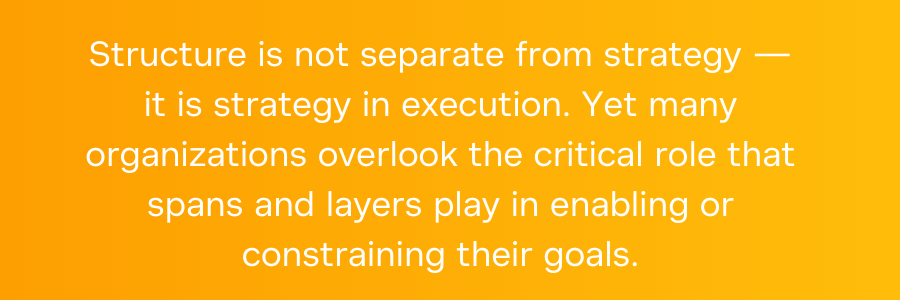In today’s data-driven world, leaders are eager to harness the power of metrics. Yet many find themselves drowning in information while struggling to surface real insight. Why? Because they’re often measuring what’s easiest to track — not what actually aligns with their strategy.
One of the most overlooked, yet critical, areas where this misalignment shows up is in the design of the organization itself — specifically, in its spans and layers.
Are You Measuring What Matters? Why Spans & Layers Might Be the Missing Link in Your Org Data
Everyone’s talking about data. Dashboards. Benchmarks. Metrics. But here’s the reality I see across organizations every week: Leaders are swimming in data — yet starving for insight. The problem? Most companies measure what’s easy, not what’s strategic. And one of the most overlooked culprits behind misaligned measurement is the organizational structure itself — particularly spans and layers.
The Silent Disconnect: Data That Ignores Design
Let’s say your strategy is to move faster, scale smarter, or empower decision-making closer to the front lines. Great. But your org structure tells another story: You’ve got nine layers between the CEO and the frontline. Some managers oversee two direct reports, while others stretch across 20.
Spans & Layers: Not Just Structure — Strategic Signals
Spans of control and organizational layers aren’t just operating model features — they’re behavioral cues and design levers. Too many layers? You likely have decision latency and misalignment. Uneven spans? Your managers are either stretched too thin or underutilized. Compressed top layers? You might be signaling micromanagement from above or a lack of succession planning. These issues directly impact cost, agility, accountability, and employee experience. But most organizations aren’t tracking this in real time — and definitely not tying it back to business outcomes.
What to Do Instead: A Simple Alignment Check
As you look across your data dashboards, ask: What is our strategy really asking of our organization? How is our current structure helping or hurting that? Do we understand how spans/layers influence decision rights, cost, and leadership clarity? Are we tracking structure as a system — or just the symptoms? The best-performing organizations treat org data like business intelligence, not just HR reporting. And that starts with rethinking what we measure and why.
Let’s Bring This into the Room

Spans and layers aren’t just structural choices — they are direct expressions of how your organization operates. They influence the speed of decision-making, the clarity of accountability, and the real distribution of power.
Structure is not separate from strategy — it is strategy in execution. Yet many organizations overlook the critical role that spans and layers play in enabling or constraining their goals.
It’s time we stopped viewing org charts as administrative tools and started treating them as what they truly are: the architectural blueprint of business logic. Measured, monitored, and optimized, they become one of the most powerful levers for organizational performance.





